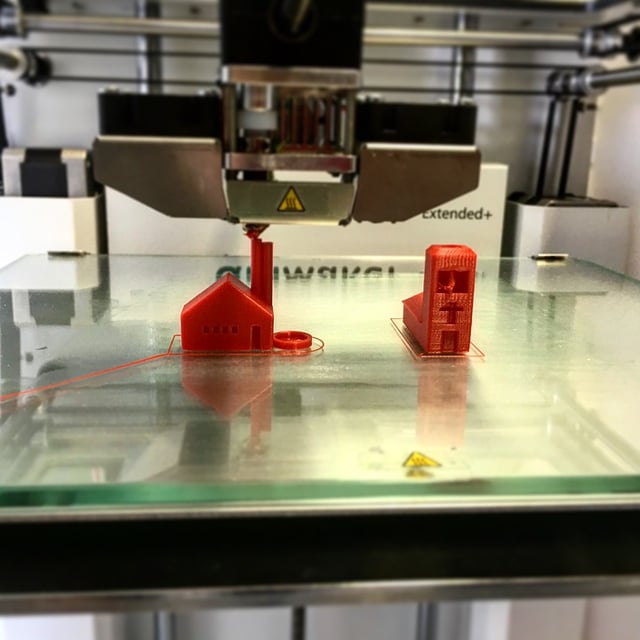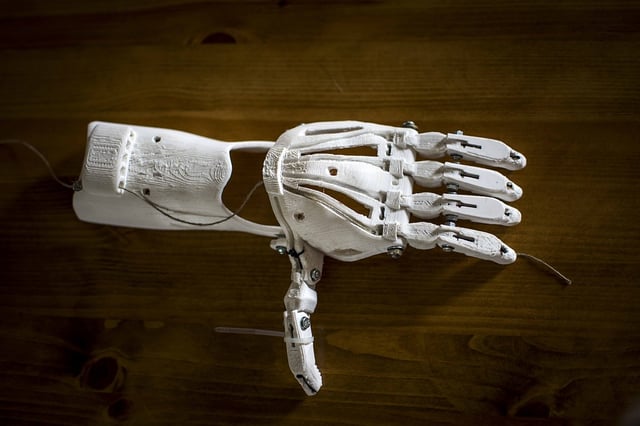Hot Out of the Box: the Latest 3D-Printed Robots

Three-dimensional printing is one of the most innovative, remarkable technologies to emerge and evolve over the past several decades, yet it seems to have burgeoned into the mainstream media in recent years.
Home personal computers can now build parts from three-dimensional models, using a specialized printer that layers a variety of materials from metal to wax to plastic to create an object. Machines can be assembled from these parts, making home manufacturing feasible and affordable.The process has become mature enough that fairly complex, high-tech machines can be produced by anyone who is reasonably handy and willing to learn a few computer skills. Some more memorable examples of recent 3D accomplishments in the news include functioning guns, housings for digital devices, and even working automobiles. One such arena where this advancing technology has made serious inroads is in the field of robotics and automation. The suitability of 3D printing to create complex computer-designed surfaces to produce housings for devices such as computers, radios, music players and appliances translates well to the need for unusual, custom enclosures and specialized parts used by robot creators. Structural components including struts, joints, reinforcements, and mounting plates can be quickly printed on an as-needed basis, making the assembly of robotic devices highly efficient.Below is a sampling of the latest astounding, ingenious 3D printed robotic projects from various auspicious organizations and individuals.
Junior: the robotic translator
Rishabh Java, a 15-year-old tenth-grader in Dubai, won a recent science competition (the World 3D-Printing Olympiad) with a robot assembled primarily of 3D printed parts. In total, he only used about a kilogram of plastic to create “Junior,” his affectionately-named bot. Rishabh says that his life-sized robot can speak seven languages, which presents the possibility that the machine could function as a translator with a more accessible, anthropomorphic appearance than the standard tablets and phone-sized devices usually used for such tasks. Junior responds to Rishabh’s voice commands and Rishabh is currently working on adding arms, legs, and a touch-sensitivity feature to the robot. Junior can also play music and perform simple, repetitive tasks to top off its already impressive, complex functionality. The young designer previously created a 3D printed arm intended for human amputees, a design that is currently undergoing implementation in a hospital system in India.
Nao: robot companions for vulnerable populations
Softbank Robotics makes a two-foot-tall humanoid robot model called Nao. The robot has a cartoonish, smile-inducing appearance, with a large head and eyes, similar to a human child. Nao is manufactured almost entirely from 3D printed parts to house his electronics and motorized components. When the Nao robot is programmed using Zora software, produced by a Belgian company called ZoraBots, it becomes an interactive companion. One such companion is health care executive Phil Parker’s robot, appropriately named Boo Boo, which Parker uses to motivate and engage children undergoing therapy and hospital treatment for serious diseases and injury. Boo Boo helps to lift their spirits, a vital component of the healing process. Many children are understandably downcast during their time in the hospital, and Boo Boo is an important tool to get these children moving and laughing. Nao, or Boo Boo, is not the first 3D printed robot to provide social support to children. Maki, from Hello Robo, is a small humanoid robot that comforts hospitalized children and has been most often used in helping young ones deal with the pain of IV placement. Nao’s robotic empathy doesn’t stop with children. The robot has made appearances in elder care facilities too, another vulnerable demographic that finds stress and anxiety relief in visits from the automated friend.
Robotic fruit picking
Another Belgian company, Octinion, has developed an agricultural robot that’s able to maneuver with precision, determine the ripeness of growing strawberries, and gently pick the berries without harming them. Increasing demand for fresh produce and rapidly increasing costs of human labor to harvest it are driving a growing market for automated devices to aid in the harvest.Strawberries are delicate, necessitating unusual levels of “feel” and soft gripping pressure. The picking surface is 3D printed from a pliable material which spreads the picking pressure across the surface of the fruit, instead of just grasping at two discrete points on the berry. This is a breakthrough makes the robot commercially feasible.
Autonomous robotic navigation
In San Diego, researchers have created an autonomous robot capable of negotiating uneven and rough terrain such as branches, rocks, beaches, and piles of debris. The secret to their approach is in the design of the legs, which are designed to mimic the action of tree branches by bending in every direction like a spring, rather than using joints. A critical step in this innovation is the use of 3D printing to combine stiff and soft materials to create each of the machine’s four legs. University of California, San Diego mechanical engineering professor Mike Tolley, who led the project, explains that this design more closely resembles that of living creatures, with stiff yet flexible “bones” surrounded by soft, deformable “flesh.”
ASLAN: the sign language signaling robotic arm
According to the World Health Organization, over 5% of the world’s population has highly impaired hearing loss or deafness, meaning that providing sign language interpretation for these individuals is imperative in many instances. At the University of Antwerp (Belgian, yet again!), graduate students have developed a robotic arm that can understand sign language, signaling broader hope for the future in meeting this demand. It’s called ASLAN and it can learn sign language gestures from a special input glove and play them back. The next goals are to give the machine the ability to recognize speech and visual recognition of sign language by camera vision. The students also plan to include another hand and a face component that can add subtle facial cues to the translation work.
Choitek’s ASPIR instructable allows you to print and build your own robot
Finally, in a huge, ten-chapter article at Instructables.com, Choitek lays out how to 3D print a completely functional humanoid robot named ASPIR. The instructions detail how to 3D print over 11 pounds of plastic, connecting nearly three dozen servos, an Android phone, laser rangefinder, and a web camera. The printing alone is projected to take over 300 hours. The ending robotic result, ASPIR, can recognize people, look at them, and carry on a conversation.Now, home-based designers have capabilities within reach to create entire autonomous humanoids that can speak and simulate emotions, performing menial tasks to free their human counterparts for more productive pursuits. The technology is often available to the public and the barriers to entry are considerably low for such useful and sophisticated technology. Perhaps it’s time to invest in a 3D printer.
Olivia Warfield is a contributing writer and media relations specialist for TriMet. She writes for a variety of technology and digital development blogs and is especially interested in the rising prominence of 3D technology for both business and recreation.









Leave a comment